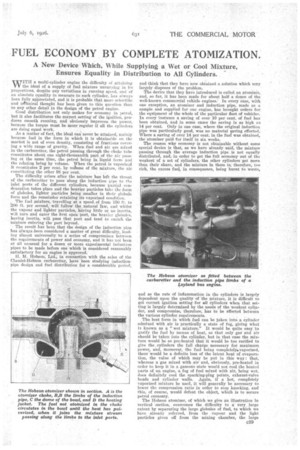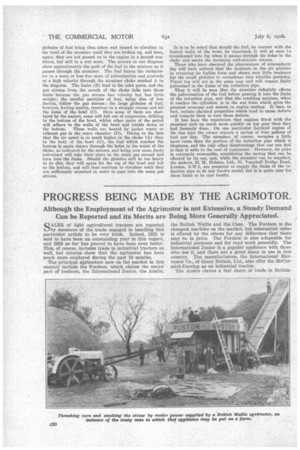FUEL ECONOMY BY COMPLETE ATOMIZATION.
Page 9

Page 10

If you've noticed an error in this article please click here to report it so we can fix it.
A New Device Which, While Supplying a Wet or Cool Mixture, Ensures Equality in Distribution to All Cylinders.
WITH a multi-cylinder engine the difficulty of attaining the ideal of a supply of fuel mixture unvarying in its proportions, despite any variations in running speed, and of .an absolute equality in measure to each cylinder, has always
• been fully appreciated, and it is probable that more scientific and tethnical thought has been given to this question than to any other detail in the design of the petrol engine. Good distribution.not only makes for economy in petrol, but it also facilitates the correct setting of the ignition, produces smooth running, and obviously improves. i.he power, because the torque must be more regular if all the cylinders are doing equal work.
As a matter of fact, the ideal can never be attained, mainly because fuel in the form in which it is obtainable on the market is not of even density, consisting of fractions covering a wide range of gravity. When fuel and air are mixed in the carburetter, the petrol passing, through the choke tube
• constitutes about one eight-thousandth part of the air passing at the some time, the petrol being in liquid form and the relation being by volume. When the _petrol is vaporizA it constitutes '2 per cent. by vtlume of the mixture, the air constituting the other 98 per cent.
The difficulty arises after the mixture has left the throat of the carburetter to pass along the induction pipe to the inlet ports of the different cylinders, because partial condensation takes place and the heavier particles take the form of globules, lighter particles being smaller in their globule form and the remainder retaining its vaporized condition.
The fuel mixture, travelling at a speed, of from 150 ft. to '200 ft. per second,' will follow the natural taw, and whilst the vapour and lighter particles, having little or no inertia, will turn and enter the first open port, the heavier globules, having inertia, will pass that port and tend to enrich the Mixture entering the port beyond.
• The result has been that the design of the induction pipe has always .been considered a matter of great difficulty, leading almost universally' to rt. series of compromises between the requirements of power and economy, and it has not been at all unusual for a dozen or more experimental induction pipes to be made before one which is considered reasonably
satisfactory for an engine is approved. .
H. NI. Hobson, Ltd., in connection with the sales of the Claudel-Hobson carburetter, have been studying inductionpipe design and fuel distribution for a considerable period, and think that they have now obtained a solution which very largely disposes of the problem.
The device that they have introduced is called an atomizer, and, so far, it has been made for about half a dozen of the well-known commercial vehicle engines: In every case, with one exception, an atomizer and induction pipe, made as a sample and supplied for one engine, has brought orders for. the equipment of the whole of the particular fleet of vehicles. In every instance a saving of over 10 per cent. of fuel has been obtained, and in some cases the saving is as high as 14 per cent. Only in one case, where the original induction pipe was particularly good, was no material saving effected. Where a saving of over 14 per cent, in the fuel was obtained, the atomizer paid for itself in six weeks.
The reason why economy is not obtainable without some special device is that, as we have already said, the mixture passing through the average induction pipe is not equally distributed, and, in order to get the full economy out of the weakest of a set of cylinders, the other cylinders get more than their share, and the mixture in them is, therefore, too rich, the excess fuel, in consequence, being burnt to waste,
and as the rate of inflammation in the cylinders is largely dependent upon the quality of the mixture, it is difficult to get correct ignition setting for all cylinders when that setting is largely determined by the needs of the weakest cylinder, and compromise, therefore, has to be effected between the various cylinder requirements.
The best form in which fuel can be taken into a cylinder admixed with air is practically a state of fog, giving what i3 known as a 'wet mixture." It would be quite easy to gasify the fuel by means of heat, so that only gas and air should be taken into the cylinder, but in that case the mixtime would be so pre-heated that it would be too rarified to give the ,cylinders the full charge necessary for maximum power, and, moreove,r, the fuel being completely, vaporized, there-would be a definite loss of the latent heat of evaporation, the value of which may be put in this way : that, whereas a gas mixed with air and, obviously, pre-heated in order to keep it in a gaseous state would not cool the heated parts of an. engine, a fog of fuel mixed with air, being wet, does definitely cool the sparking-plug points, exhaust-valve heads and cylinder walls. Again, if a hot, completely vaporized mixture be used, it will generally be necessary to lower the compression ratio in order to stop knocking, and this, of course, would defeat the object, which is to secure petrol economy.
The Hobson atomizer, of which we give an illustration in vertical section, overcomes the difficulty to a very largo extent by separating the large globules of fuel, to which we have already referred, from the vapour and the light Particles given off from the mixing chamber, the large
globules of fuel being then taken and caused to circulate in the bowl of the atomizer until they are broken up, and here, again, they are not passed on to the engine in a heated condition, but still in a wet state. The arrows in our diagram show approximately the path of the fuel in the mixture as it passes through the atomizer. The fuel leaves the carburetter in a more or less fine state of pulverization and proceeds at a high velocity through the atomizer choke marked A in the diagram. The limbs (B) lead to the inlet ports, and the gas stream from the mouth of the choke falls into these limbs because the gas stream has velocity but has little weight; the smaller particles of fuel, being also of low inertia, follow the gas stream; the large globules of fuel, however, having inertia, continue in a straight course, and hit the dome of the bowl (C). Here some of them are shattered by the impact, some will fall out of suspension, drifting to the bottom of the bowl, whilst other parts of the petrol will adhere to the walls of the bowl and trickle down to the bottom. These walls are heated by jacket water or exhaust gas in the outer chamber (D). Owing to the fact that the air speed is so much higher in the choke (A) than in the body of the bowl (C), the fuel which reaches the bottom is again drawn through the holes in the waist of the choke, as indicated by the arrows, and being now more finely Pulverized will take their place in the main gas streani and turn into the limbs. Should the globules still be too heavy to do this, they will again hit the top of the bowl and fall to the bottom, and will thus continue to circulate until they are sufficiently atomized in order to pass into the main gas stream.
It is to be noted that should the fuel, by contact with the heated walls of the bowl, be vaporized, it will at once La recondensed into fog when it passes through the holes in the choke and meets the incoming cold-mixture stream.
Those who have observed the phenomenon of atmospheric fog will have noticed that the moisture in the air persists in retaining its foglike form and shows very little tendency for the small globules to recondense into rainlike particles. Petrol fog will act in the same way and will remain finely pulverized in the limbs of the induction pipe.
Thus it will be seen that the atomizer definitely effects the pulverization of the fuel before passing it into the limbs of the induction pipe, and that the resulting mixture, when it reaches the cylinders, is in the wet form which gives the greatest economy and assists in engine cooling. It uses, in fact, certain physical properties which tend to cause defects and compels them to cure those defects.
It has been the experience that engines fitted with the atomizer pick up much more quickly on top gear than they had formerly done. On one particular Leyland engine of the bus type the owner reports a saving of four gallons of fuel per day. The atomizer, of course, occupies a little more room than the portion of the induction pipe Which it displaces, and the only other disadvantage that one can find is that it adds to the cost of equipment. However, its price is extremely reasonable, considering the saving that can be effected by its use, and, while the atomizer can be supplied, the makers, H. M. Hobson, Ltd., 31, Vauxhall Bridge Road, London, S.W.1, are prepared to supply the limbs of the induction pipe to fit any known model, but it is quite easy for these limbs to he cast locally.
















































